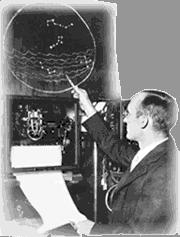Astronomy Bio...Karl Jansky
Jay Bitterman

As a follow-up of February's Who's Who personality, I thought it would be interesting to know more about Karl Jansky, the pioneer of radio astronomy.
Jansky was born at Norman, Oklahoma, on 22 October, 1905. He was educated at the University of Wisconsin, where his father was a member of the Faculty. He spent a year as an instructor before beginning his career as an engineer with the Bell Telephone Laboratories in 1928. In 1932 he discovered the existence of extraterrestrial radio waves. (The photo shows Jansky pointing toward the Milky Way as the source of the radiation.) Thereafter, Jansky did not continue this kind of scientific work. He became more involved with engineering and left the research in astronomy to others. Jansky died of a heart ailment at Red Bank, New Jersey, on 14 February, 1950.
As a research engineer at the Bell Telephone Company, he was assigned the task of tracking down and identifying the various types of interference from which radio telephony and radio reception were suffering. The company was particularly concerned with the interference that occurred at short wavelengths of around 15 m (then being used for ship-to-shore radio communications). It was well known that some of the static interference was caused by thunderstorms, nearby electrical equipment or aircraft. By building a high quality receiver and aerial system that was mounted on wheels and could be rotated in various directions, Jansky was able to detect a new and unidentifiable kind of static. After months of study, Jansky associated the source of the unidentified radio interference with the stars. He had noticed that the background hiss on a loudspeaker attached to the receiver and antenna system reached a maximum intensity every 24 hours. From overhead it seemed to move steadily with the Sun but gained on the Sun by four minutes per day.
This amount of time correlates with the difference of apparent motion, as seen on Earth, between the Sun and the stars, and so Jansky surmised that the source must lie beyond the Solar System. By the spring of 1932 he had concluded that the source lay in the direction of Sagittarius. This was the direction which the American astronomer, Harlow Shapley (1885 1972), and the Dutch astronomer Jan Oort (1900 - ??) confirmed as being in the direction of the center of our Galaxy. Jansky published his results in December 1932. In the same month, Bell Telephone Laboratories issued a press release on Jansky's discovery to the New York Times and it made front-page news. This was the birth of radio astronomy. There was now a second region of the electromagnetic spectrum in which it was possible to study the stars, a radio window on the Universe. There was no immediate follow-up to Jansky's discovery, however, and it was left to an American amateur astronomer, Grote Reber, to pursue the matter. It was not until the end of World War II that the importance of radio astronomy began to be recognized.
Although Jansky died at an early age, he did live long enough to see radio astronomy develop into an important tool of modern astronomical research. By their ability to penetrate the Earth's atmosphere and dust clouds in space, radio telescopes enable the study of celestial objects that are impossible to detect by optical means. In 1973, in honor of Karl Jansky, the International Astronomical Union named the unit of strength of a radio-wave emission a "Jansky" (symbolized Jy).
Published in the April 1999 issue of the NightTimes




